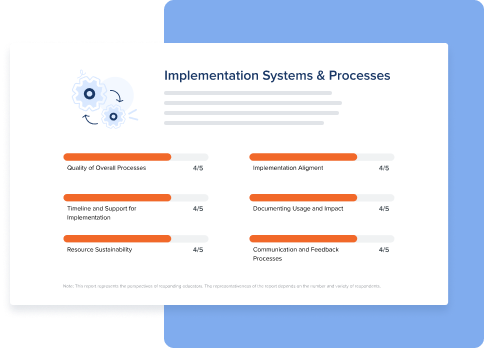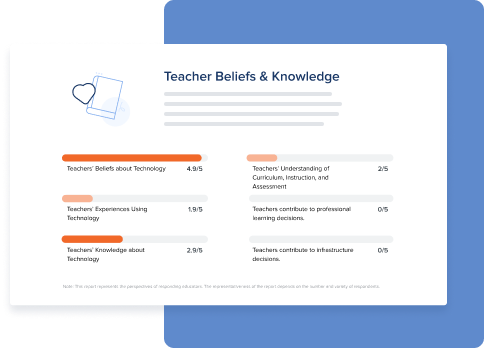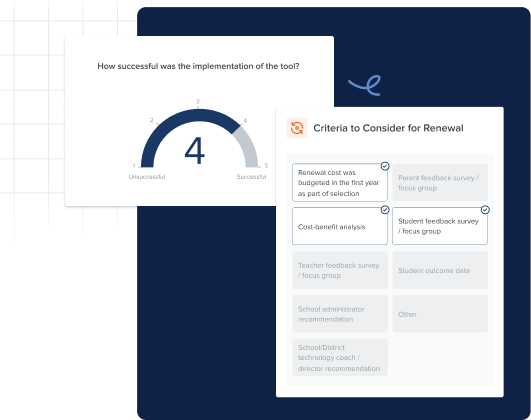Learn from educators like you
Tell us about yourself and your setting to describe your implementation context and be matched to reports about edtech implementation written by educators in contexts just like yours.
Tell us about yourself and your setting to describe your implementation context and be matched to reports about edtech implementation written by educators in contexts just like yours.

Learn about 10 variables that are likely to impact your school or district’s success or failure with edtech implementation.
Review evidence from educators working in contexts like yours about what worked, what didn’t, and what they would recommend to improve edtech implementation.
Download the most useful evidence to share with colleagues and support your school or district’s decision-making.

The Exchange Platform is powered by educators. Educators across the country share their experiences implementing edtech to help one another make informed decisions. Want to share your experience? Sign up to contribute here.
Access the Exchange Platform and create an account. Your personal information will be stored securely and never shared.
Complete the 30 minute context inventory to tell us about yourself and your edtech implementation context. This information will let the Exchange Platform match you to educators working in contexts like yours. Encourage your colleagues to participate and increase the reliability of the match!
Once your Context Inventory is complete, you will have access to two types of evidence:
The Context Report describes your district’s edtech implementation context in terms of 10 variables identified by the EdTech Genome Project as likely to influence edtech implementation. The report shows the average of all educators’ responses in your district for each variable.
Teacher agency is the extent to which teachers consistently have a voice in shaping their work, as well as the conditions and tools for that work.

Visioning helps schools and districts recognize opportunities for technology to address problems of practice, prioritize equity, and plan for technology integration that promotes student learning opportunities.

Selection process are the presence and quality of consistent methods through which classrooms / schools / districts / states identify, evaluate, and choose education technology to meet established student and teacher needs for learning and instruction.

Implementation systems and processes occur after procurement and are the presence and quality of methods through which school communities put education technology into effect over time to achieve intended outcomes.

Teacher beliefs and knowledge is individual teachers’ perceived ability to use education technologies and integrate them into their practice.

Competing priorities is the extent to which a school or district has other prioritized initiatives that impact the available time and attention for new education technology implementations.

Strategic leadership support is the extent to which district and school leaders provide explicit encouragement and guidance to faculty and staff who are selecting and implementing education technology tools.

Staff culture refers to the set of beliefs, values, norms, and assumptions that are shared collectively by the school and / or district staff and that influence the way in which staff members work individually and collaboratively to fulfill the school’s shared vision for teaching and learning.

Infrastructure and operations are the enabling conditions that lower barriers for implementation, facilitate uptake, and support scaling and sustaining new education technology.

Professional learning is the presence, duration, and quality of a range of intentional, adult learning activities that support the effective integration of technology to advance student learning and outcomes.
Elevate your decision making process by getting access to the experiences and knowledge of your peers.
Implementation Reports provide information about which edtech tools are most likely to work in your classroom, school, and district.

Tool and Author describes the teacher who authored the implementation report and the technology on which the implementation report focuses.

Use Case describes the teacher’s use of the technology in their classroom with specific student populations and their perception of how well the technology fits with the curriculum.

Target Outcomes identifies the academic and/or social-emotional outcomes the teacher intended for the technology to impact and the teacher’s perception of the extent to which the technology did impact the target outcomes.

Perceived Success describes the teacher’s perception of how successful the technology is in improving intended student outcomes, impacting student learning experiences, or engaging students in the learning process. This is compared to aggregate perceptions of other educators in their school or district.

Usage Goals details any personal, school, or district usage goals for the technology, how those goals were measured, and the teacher’s perception of if those goals were met.

Logistics and Timing describes the initial setup required to use the technology, what devices are used with the technology, and how often and how long students use the technology.

Ease of Use and Skills Needed describes the teacher’s perception of how easy or difficult it is for the teacher and the students to use the technology and what skills were needed to use it.

Issues and Potential Bias covers any problems that the teacher or students encountered while using the technology and how they were solved. The teacher specifically identifies any possible sources of bias they identified in the technology.

Professional Learning includes information on any professional learning opportunities and resources the teacher accessed to help learn the logistics of using the technology or how to integrate the technology into lessons.

Satisfaction describes the teacher’s feelings about the technology’s implementation in the district, school, and classroom and how the author thinks students feel about the technology.

Advice details any recommendations the teacher has for colleagues working in a similar context about planning to use the technology, helping students learn with the technology, and how to manage student behavior while using the technology. The teacher also identifies if they would use the technology again.

Technology & Author describes the decision maker who authored the implementation report and the technology on which the implementation report focuses.

Technology & Author describes the decision maker who authored the implementation report and the technology on which the implementation report focuses.

Target Outcomes identifies the academic and/or social-emotional outcomes the decision maker intended for the technology to impact and the decision maker’s perception of the extent to which the technology did impact the target outcomes.

Perceived Success describes the decision maker’s perceptions of how successful the technology is in improving intended student outcomes, impacting student learning experiences, and engaging students in the learning process. This is compared to aggregate perceptions of other educators in their school or district.

Identifying covers the problem the decision maker was trying to solve by selecting a technology, other technologies they considered, and why they chose this specific technology to solve the identified problem.

Evaluation & Pilot describes how the technology was evaluated during the selection process, including what criteria and evidence the decision maker used to evaluate the technology.

Selection identifies who was involved in the final selection decision and how much time was involved in the selection process.

Usage Goals details any usage goals set for the technology by the school or district, how those goals were measured, and the decision maker’s perception of if those goals were met.

Logistics & Timing includes information on the steps involved in integrating the technology into schools and/or the district and how long the process took. This includes information on the need to purchase new devices, to adjust the technology infrastructure, and to determine if the technology meets the district’s data privacy standards.

Professional Learning includes information on any professional learning opportunities on the technology that were offered. This includes how successful the decision maker perceives the professional learning was to help teachers learn the logistics of using the technology and help them effectively integrate the technology into their lessons.

Response & Overall Success describes the decision maker’s perceptions of student, teacher, and administrator responses to the technology, what factors the author believes impacted their positive or negative responses, and to what extent the decision maker believes the technology implementation is successful.